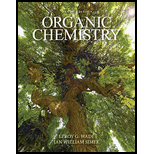
Organic Chemistry Plus Mastering Chemistry with Pearson eText -- Access Card Package (9th Edition) (New in Organic Chemistry)
9th Edition
ISBN: 9780321971128
Author: Leroy G. Wade, Jan W. Simek
Publisher: PEARSON
expand_more
expand_more
format_list_bulleted
Concept explainers
Question
Chapter 26.7C, Problem 26.17P
Interpretation Introduction
Interpretation:
A mechanism for the formation of Bisphenol A by the condensation of phenol with acetone is to be represented and catalyst for the reaction is to be suggested.
Concept introduction:
Condensation polymerisation is the process for the formation of
Expert Solution & Answer
Want to see the full answer?
Check out a sample textbook solution
Students have asked these similar questions
What is the product of the following reaction? Please explain what is happening in this question. Provide a detailed explanation and a drawing showing how the reagent is reacting with the catalysts to product the correct product. The correct answer is B.
What is the missing intermediate 1 and the final product 2. Please include a detailed explanation explaining the steps of malonic ester synthesis. Please include drawings of the intermediate and how it occurs and how the final product is former.
What would be the reagents and conditions above and below the arrow that will complete the proposed acetoacetic ester synthesis? If it cannot be done efficiently, then I will choose that answer. There could be 2 or 4 reagents involved. Please provide a detailed explanation and drawings showing how it would proceed with the correct reagents.
Chapter 26 Solutions
Organic Chemistry Plus Mastering Chemistry with Pearson eText -- Access Card Package (9th Edition) (New in Organic Chemistry)
Ch. 26.2A - Show the intermediate that would result if the...Ch. 26.2A - Prob. 26.2PCh. 26.2A - Prob. 26.3PCh. 26.2B - Prob. 26.4PCh. 26.2B - Prob. 26.5PCh. 26.2B - Chain branching occurs in cationic polymerization...Ch. 26.2C - Prob. 26.7PCh. 26.2C - Prob. 26.8PCh. 26.2C - Chain branching is not as common with anionic...Ch. 26.3 - Prob. 26.10P
Ch. 26.5 - Prob. 26.11PCh. 26.6 - Prob. 26.12PCh. 26.7A - Prob. 26.13PCh. 26.7B - Prob. 26.14PCh. 26.7B - Prob. 26.15PCh. 26.7C - a. Propose a mechanism for the reaction of...Ch. 26.7C - Prob. 26.17PCh. 26.7D - Prob. 26.18PCh. 26.7D - Prob. 26.19PCh. 26.7D - Prob. 26.20PCh. 26 - Prob. 26.21SPCh. 26 - Prob. 26.22SPCh. 26 - Poly(trimethylene carbamate) is used in...Ch. 26 - Prob. 26.24SPCh. 26 - Urylon fibers are used in premium fishing nets...Ch. 26 - Prob. 26.26SPCh. 26 - Prob. 26.27SPCh. 26 - Polyoxymethylene (polyformaldehyde) is the tough,...Ch. 26 - Prob. 26.29SPCh. 26 - Prob. 26.30SPCh. 26 - Prob. 26.31SPCh. 26 - Prob. 26.32SPCh. 26 - Prob. 26.33SPCh. 26 - Prob. 26.34SPCh. 26 - The polyester named Lactomer is an alternating...Ch. 26 - Prob. 26.36SP
Knowledge Booster
Learn more about
Need a deep-dive on the concept behind this application? Look no further. Learn more about this topic, chemistry and related others by exploring similar questions and additional content below.Similar questions
- For benzene, the ∆H° of vaporization is 30.72 kJ/mol and the ∆S° of vaporization is 86.97 J/mol・K. At 1.00 atm and 228.0 K, what is the ∆G° of vaporization for benzene, in kJ/mol?arrow_forwardThe reaction Q(g) + R(g) → Z(l) is shown to be exothermic. Which of the following is true concerning the reaction. it is spontaneous only at High T, it is spontaneous at low T it is nonspontaneous at all T it is spontanrous at all T. it is non spontaneous only at low T.arrow_forwardThe reaction Q(g) + R(g) → Z(l) is shown to be exothermic. Which of the following is true concerning the reactionarrow_forward
- Which of the following has the largest standard molar entropy, S° (298.15 K) He H2 NaCl KBr Hgarrow_forwardWhich of the following is true for a particular reaction if ∆G° is -40.0 kJ/mol at 290 K and –20.0 kJ/mol at 390 K?arrow_forwardWhat is the major product of the following reaction? O O OH OH 1. BH 2. H₂O₂, NaOH OH OHarrow_forward
- How many products are possible from the following reaction? Do not take into account stereoisomers. 01 04 03 O O O O 02 CH H₂SO4 heatarrow_forwardplease helparrow_forwardChoose the major product of the reaction with correct regio- and stereochemistry. Br2 H₂O O "Br Br & O 'Br OH Br 吡 O OH OH Br "OH Brarrow_forward
arrow_back_ios
SEE MORE QUESTIONS
arrow_forward_ios
Recommended textbooks for you

 Organic ChemistryChemistryISBN:9781305580350Author:William H. Brown, Brent L. Iverson, Eric Anslyn, Christopher S. FootePublisher:Cengage Learning
Organic ChemistryChemistryISBN:9781305580350Author:William H. Brown, Brent L. Iverson, Eric Anslyn, Christopher S. FootePublisher:Cengage Learning Organic Chemistry: A Guided InquiryChemistryISBN:9780618974122Author:Andrei StraumanisPublisher:Cengage Learning
Organic Chemistry: A Guided InquiryChemistryISBN:9780618974122Author:Andrei StraumanisPublisher:Cengage Learning


Organic Chemistry
Chemistry
ISBN:9781305580350
Author:William H. Brown, Brent L. Iverson, Eric Anslyn, Christopher S. Foote
Publisher:Cengage Learning

Organic Chemistry: A Guided Inquiry
Chemistry
ISBN:9780618974122
Author:Andrei Straumanis
Publisher:Cengage Learning